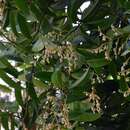ar
الأسماء في صفحات التنقل


Dryobalanops is a genus of flowering plants and the genus of family Dipterocarpaceae. The name Dryobalanops is derived from Greek (dryas = a nymph associated with oaks and balanops = acorn) and describes the acorn-like nut. The genus has seven species, confined to the tropical forests of West Malesia (Sumatra, Peninsular Malaysia and Borneo). It is among the most abundant species of emergent trees in these forests,[1] growing up to 80 m tall.
The genus is of considerable importance as timber trees and sold under the trade name Kapur. The timber is an important heavy and durable construction timber. D. aromatica was an important source of camphor.
As the trees mature, they mutually avoid touching each other in a phenomenon known as crown shyness.
Dryobalanops is a genus of flowering plants and the genus of family Dipterocarpaceae. The name Dryobalanops is derived from Greek (dryas = a nymph associated with oaks and balanops = acorn) and describes the acorn-like nut. The genus has seven species, confined to the tropical forests of West Malesia (Sumatra, Peninsular Malaysia and Borneo). It is among the most abundant species of emergent trees in these forests, growing up to 80 m tall.
The genus is of considerable importance as timber trees and sold under the trade name Kapur. The timber is an important heavy and durable construction timber. D. aromatica was an important source of camphor.
As the trees mature, they mutually avoid touching each other in a phenomenon known as crown shyness.
Dryobalanops es un género botánico con siete especies de plantas con flores perteneciente a la familia Dipterocarpaceae.[1]
El género tiene siete especies que se encuentran en los bosques tropicales del oeste de Malasia (Sumatra, Península de Malasia y Borneo). Se encuentra entre las más abundantes especies de árboles emergentes de estos bosques.[2]
El género es de considerable importancia económica por su madera que es vendida con la marca registrada de Kapur. La madera es dura y consistente para la construcción de muebles. D. aromatica era una importante fuente de alcanfor.
El género fue descrito por Karl Friedrich von Gärtner y publicado en Supplementum Carpologiae 49. 1805.[3] La especie tipo es: Dryobalanops aromatica
Dryobalanops: nombre genérico que deriva del griego (dryas = una ninfa de los robles y balanops = bellota) y describe la forma de la bellota.
Dryobalanops es un género botánico con siete especies de plantas con flores perteneciente a la familia Dipterocarpaceae.
El género tiene siete especies que se encuentran en los bosques tropicales del oeste de Malasia (Sumatra, Península de Malasia y Borneo). Se encuentra entre las más abundantes especies de árboles emergentes de estos bosques.
El género es de considerable importancia económica por su madera que es vendida con la marca registrada de Kapur. La madera es dura y consistente para la construcción de muebles. D. aromatica era una importante fuente de alcanfor.
Dryobalanops est un genre qui regroupe plusieurs dizaines d'espèces d'arbres de grande taille de la famille des Dipterocarpaceae, originaires du sud-est asiatique, en particulier de Malaisie, Sumatra, Bornéo. Ces arbres, appelés communément kapur, sont recherchés pour leur bois et leur résine.
(cette liste n'est pas exhaustive et comprend des synonymes) :
Dryobalanops est un genre qui regroupe plusieurs dizaines d'espèces d'arbres de grande taille de la famille des Dipterocarpaceae, originaires du sud-est asiatique, en particulier de Malaisie, Sumatra, Bornéo. Ces arbres, appelés communément kapur, sont recherchés pour leur bois et leur résine.
Dryobalanops é um género botânico pertencente à família Dipterocarpaceae[1].
Dryobalanops é um género botânico pertencente à família Dipterocarpaceae.
«Dryobalanops — World Flora Online». www.worldfloraonline.org. Consultado em 19 de agosto de 2020Dryobalanops Dipterocarpaceae familyasında sınıflandırılan çiçekli bitki cinsidir. Dryobalanops adı Eski Yunanca meşelerle bağlantılı bir orman perisi olan dryas ile meşe palamudu anlamında balanops sözcüklerinden oluşturulmuştur.
Cinsin yedi türü Batı Malezya'nın (Sumatra, Malezya Yarımadası ve Borneo) tropikal ormanlarında yetişir. Yağmur ormanlarında en çok bulunan türlerden olan bu ağaçlar[1] 80 m. uzunluğa erişebilmektedir.
Türün ağaçlarından kereste elde edilmektedir. Bu keresteler dayanıklı ve ağırdır. D. aromatica türü kafur kaynağıdır.
Dryobalanops Dipterocarpaceae familyasında sınıflandırılan çiçekli bitki cinsidir. Dryobalanops adı Eski Yunanca meşelerle bağlantılı bir orman perisi olan dryas ile meşe palamudu anlamında balanops sözcüklerinden oluşturulmuştur.
Cinsin yedi türü Batı Malezya'nın (Sumatra, Malezya Yarımadası ve Borneo) tropikal ormanlarında yetişir. Yağmur ormanlarında en çok bulunan türlerden olan bu ağaçlar 80 m. uzunluğa erişebilmektedir.
Türün ağaçlarından kereste elde edilmektedir. Bu keresteler dayanıklı ve ağırdır. D. aromatica türü kafur kaynağıdır.
Dryobalanops C.F.Gaertn, 1805
Типовой видДриобаланопс (лат. Dryobalanops) — род цветковых растений семейства Диптерокарповые (Dipterocarpaceae).
Название происходит от греческого dryas = нимфа, которую связывают с дубами и balanops = жёлудь.
В род входят семь видов деревьев. Эти деревья, высота которых может достигать 80 м[3], являются источником древесины под названием капур, а вид D. aromatica ранее был важным источником камфоры. Распространены они в тропических лесах Суматры, Малайзии и Борнео. Для них характерна застенчивость кроны.
Род включает не менее семи видов[4].
Дриобаланопс (лат. Dryobalanops) — род цветковых растений семейства Диптерокарповые (Dipterocarpaceae).
Название происходит от греческого dryas = нимфа, которую связывают с дубами и balanops = жёлудь.
В род входят семь видов деревьев. Эти деревья, высота которых может достигать 80 м, являются источником древесины под названием капур, а вид D. aromatica ранее был важным источником камфоры. Распространены они в тропических лесах Суматры, Малайзии и Борнео. Для них характерна застенчивость кроны.
용뇌수속(龍腦樹屬, 학명: Dryobalanops 드리오발라놉스[*])은 딥테로카르푸스과의 속이다.[1] 7종이 동남아시아의 말레이반도와 보르네오섬, 수마트라섬에 분포한다.